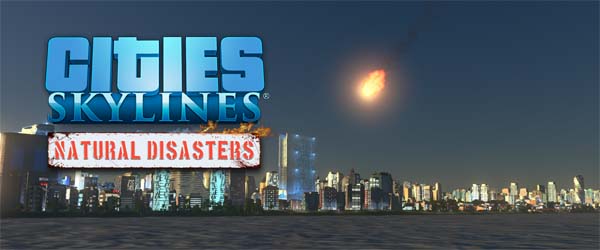
Cities: Skylines has always been a game that takes some different approaches to city builder gameplay. The base game explored how a city's geography can influence the development of the city, and also put a particular emphasis on designing efficient transit infrastructure by allowing the player incredible freedom to construct your own roads, highways, and interchanges, rather than relying on prefab ramps and over/under passes. None of these concepts were new to city builders, but Skylines added nuance to them and made them much more active elements of gameplay.
Its newest expansion DLC, Natural Disasters, follows suit. This is a very difficult expansion to review because its content - by its very nature - is random and unpredictable. Natural disasters aren't new to city builders. Disasters were a popular component of the old SimCity games, as many players enjoyed building up their beautiful metropolises only to unleash earthquakes, tornadoes, meteor impacts, and even alien invasions and dinosaur attacks and watch it all burn. Now Skylines has support for this fan-favorite SimCity feature, but it takes this commonplace feature in some new and interesting directions.
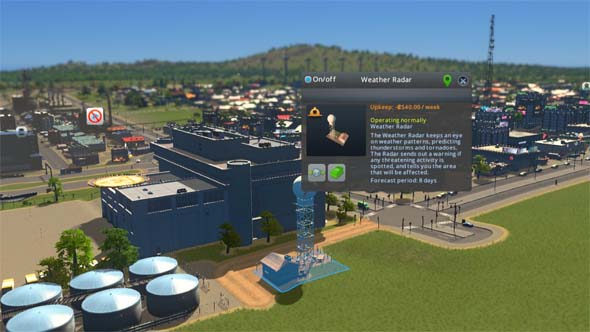
Installing early warning and detection systems will give you advance notice when a disaster is imminent.
Most notably, Cities: Skylines' take on disasters puts emphasis on preparation for disasters, rather than on the chaos of the disaster itself and the clean-up in its aftermath. Like with its SimCity forebears, disasters are something that you can toggle on or off in the game's menu, and you can also adjust their frequency. When enabled, you'll encounter disasters of various flavors ranging from forest fires to lightning strikes, to tsunami and meteor impacts. You'll have to make sure that your city is protected by preventative measures, and that it's protected against these eventualities.
Early-warning systems like firewatch towers, weather radar, and space telescopes can warn you about forest fires, storms or tornadoes, or even incoming meteors (respectively), and can mean the difference between your citizens having enough time to evacuate, or half your population being buried under rubble. You'll need evacuation shelters for you citizens to escape to, and each shelter needs to built long enough in advance for it to be stocked with supplies of food, water, and other essentials (which must be pulled from your city's economy or imported). And lastly, you'll need radio towers to warn your citizens to get to their designated shelters.
Building emergency shelters, stocking them with supplies, and planning evacuation routes will protect your citizens.
You can also create planned evacuation routes similar to bus routes that will pick up residents and take them to a shelter. I had some trouble getting these routes to work properly though. The fact that the buses are dispatched when an evacuation is activated means that they often create a log jam on your roads as they all funnel out of the shelter. I also had issues with the buses apparently not picking up people who were at more distant stops on the route, since the areas along the route that were far from the shelter never managed to evacuate. Maybe there's some trick to getting these routes to work properly that I just haven't found yet. But this does highlight one problem with the expansion: its new systems are not very well documented or explained... [More]
9ae61f59-31e1-483a-bb60-03cd1377e8b2|2|3.0
Tags:Cities: Skylines, Cities: Skylines: Natural Disasters, Colossal Order Ltd., Paradox Interactive, Steam, Steam Workshop, city simulation, DLC, expansion, disaster, natural disaster, emergency, evacuation, fire, earthquake, tornado, meteor, tsunami, flood
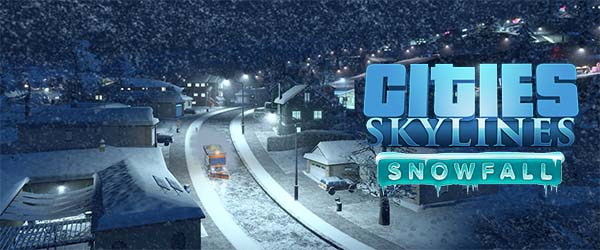
I described Cities: Skylines' first expansion, After Dark, as " just tak[ing] the Cities: Skylines canvas, and offer[ing] the player a few more colors to optionally paint with." That expansion didn't really do much to change the way that the game is really played, but rather just focused on adding further specialization options for any city that you care to build. I wasn't too upset because the core game is still a phenomenal foundation to build upon, and the expansion just gave us more to play with within that same phenomenal foundation. Snowfall, however, is even more narrow in scope. It offers one new color to paint with, and that color is white.
I got really excited when I loaded up Steam and saw the title of the new expansion. I had written a wishlist blog in which I specifically asked for the next expansion to offer seasonal weather changes and more recreational and transportation specializations suited to those different seasons. On the surface, Snowfall seemed to provide that. There's now a winter, and snow, and you can build a specialized winter wonderland. But that's the extent of what this expansion provides, and that's disappointing.
Snowfall doesn't provide a full season system or any real changes to the game's core economic loop. Instead, it has a few snowy, winter-themed maps in which you can build snow-themed cities. Those winter maps are always snowy, and the non-winter maps are never snowy (although they can see occasional rain and fog). Note: I'm going to get real tired of saying "non-winter maps", so henceforth, for the sake of simplicity, I will refer to them as "summer maps", even though summer isn't really a thing (yet). Your city doesn't progress from springing to summer to autumn to winter (or even just from summer to winter) and then back again, and you don't have to manage your economy so as to maximize profits during your tourist season and find a way to maintain employment and revenue during the off season. Depending on which map you select, it's either always winter, or it's always summer.
I complained about After Dark feeling like I had to go out of my way in order to use the expansions new features and specializations, but at least those features and specializations were available in all cities, and they could be applied to my existing cities from before the expansion. You have to go so far out of your way to use the Snowfall features that you have to start a whole new game on a specific subset of maps. It makes After Dark look like a broad game-changing expansion by comparison.
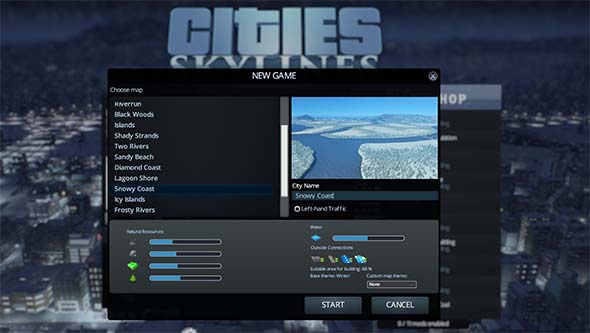
Only maps designated as "winter" maps will have snowfall, and they aren't very different from existing maps.
Disconnected from reality
The actual functionality of some of these winter buildings is also questionable. One of the first snow buildings that you'll unlock is the "snow dump", which is a landfill for snow. Snow plows in this game will drive around the city similar to garbage trucks, actually collecting the snow off the streets, and then taking them back to the snow dump building, which (according to its description) melts down the snow to make room for more snow. It seems like they just took the garbage truck functionality and copy-pasted it to apply to snow, only without the need for a separate incinerator building.
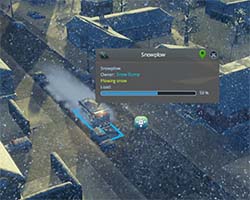
Snow can slow traffic and must be plowed.
The really weird thing is that there is also a new general road maintenance office that keeps the roads in good repair and traffic flowing smoothly. If you don't bother to build the road maintenance office, or build the snow dump or plow the snow, it will slow down your roads and eventually make them unusable. Why did these need to be two buildings? Why couldn't the road maintenance office also be the depot for snow plows?
And then there's the ski buildings, which also don't seem to work in any way comparable to real life. The ski resort is an artificial ramp that you build on flat ground. Again, that's not really how ski resorts work. Typically, a ski resort would be built high up on a mountain, where there's a natural slope and a lot of snow. The game does include a separate ski lodge building, which you could build up in a mountain, but it wouldn't work all that well. It seems to me that the Ski Resort shouldn't be a ramp, it should just be the ski lift that you build on inclined terrain, and the Ski Lodge should be built nearby and should enhance the functionality of the resort. In fact, the new snow maps don't even include mountainous terrain on which to build a more realistic ski resort and lodge. So this all seems to be a result of the game's underlying framework not having very good support for building on slopes, and Colossal Order didn't bother to design a system to allow such niche buildings like a ski resort to be built on a slope.
I may live in a desert, but I'm pretty sure that this isn't how snow plowing or ski resorts are supposed to work...
Look, I live in the desert of Las Vegas, where it was 80 degrees by mid-February, and air conditioning is not an "option" for a car. Maybe it's not my place to tell a development team in Finland how ski resorts and snow plowing are supposed to work, but I'm pretty sure that this isn't how ski resorts and snow plows work!
Don't get me wrong, these buildings are all functional, and they all work within the game's existing mechanic set. It isn't like they are broken; they're just not very realistic, and they have a disappointing feeling of sameness to them, since they don't feel functionally distinct from buildings and features that already exist. For games like this, I tend to lean towards wanting more realism whenever possible, but that's a subjective personal preference. I understand that this is just a game, and certain amounts of abstraction and creative license need to be taken... [More]
1d6478f3-d83d-487b-a545-922d69eb8b1b|6|4.2
Tags:Cities: Skylines, Cities: Skylines: Snowfall, expansion, Paradox Interactive, Colossal Order Ltd., PC, Steam, Steam Workshop, city simulation, weather, snow, rain, fog, skiing, snowboarding, sky resort, ski lodge, heating, geothermal, cold, temperature
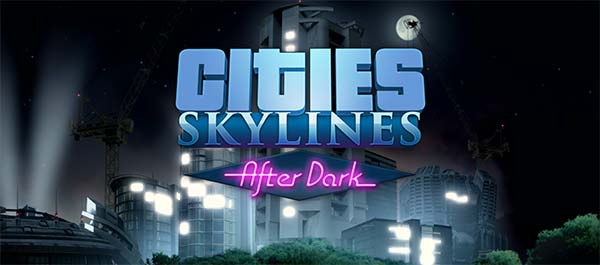
It's been a very long time since I've had a city-building game that I really enjoy. So it was a real treat to find Cities: Skylines last year. It was the first game to really capture the magic of the classic SimCity games and make them work in full 3-D, and managed to achieve the goal of abstract population agency that the SimCity reboot failed so horribly at. But as much as I loved Skylines, I was also very aware of many of its limitations. It didn't have as much content as you might expect from a game coming from a larger publisher (like EA), and there were certain elements of its abstraction that felt a little shallow or weird. The game's first expansion, After Dark, tries to address these limitations, but it doesn't really succeed.
The free update is a nice gesture, but ...
First and foremost, I have to clarify exactly what the expansion encompasses, since Colossal Order has created a bit of confusion on this topic. They launched a free update for the base Cities: Skylines game in parallel with the release of the After Dark expansion. This update included some of the core feature upgrades that the expansion's content depended on. Most notably, a day/night cycle, new zoned buildings, and upgraded crime systems. If you have Cities: Skylines, then you get these features as a free patch, and have probably been playing with them for months.
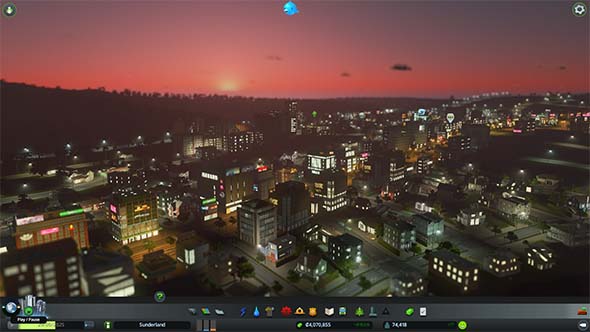
The day/night cycle is a free upgrade to the core game, but makes the core game feel somewhat incomplete.
While I applaud Colossal Order for the good will they foster by being willing to give away new functionality for free, this does kind of put players of the vanilla game in a strange situation. You get some of the new features, but not any of the ploppable buildings or city policy options that make them work. You get more crime, but not the prisons in which to lock up and rehabilitate criminals. You get the day/night cycle, but not the fancy new leisure and tourism zones that make nighttime mechanically relevant. In some ways, it takes the core game that felt very complete on its own, and suddenly makes it feel incomplete in subtle ways.
Fortunately, the menu gives you the option to turn the day/night cycle off, which helps to preserve the integrity of the original game. But then you don't get the new feature.
The update won't harm any of your existing save files though - with one major exception. If you made the unfortunate mistake of creating a city that was completely dependent on solar power, then the day/night cycle will screw that city over big time! In the core game, this was actually the most optimal way to go. Solar didn't pollute, wasn't dependent on depleting resources, and money was easy enough to make that the cost wasn't a big enough deterrent to using solar. But with the day/night update, once the sun goes down, all those fancy, expensive solar panels completely stop working! This can lead to your entire city going into a blackout as soon as you boot up your save file. Suddenly, not only is solar non-optimal, but it's practically useless since it doesn't work for half the game. And this isn't something that you can fix by just increasing solar power funding or building more plants; the power output drops to zero!
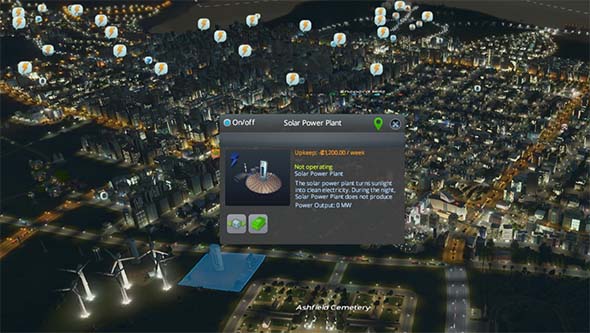
Solar power plants stop working completely during the night, leading to massive blackouts.
Fun at night, and in the sun
I did complain somewhat about the lack of a day-night cycle in the base game, but the implementation that Colossal Order gave us is a bit uncomfortable and awkward. The rapid progress of a "day" in the game means that they couldn't transition from day to night in a single game-day, or else the game would just be constantly flickering between day and night. The developers apparently didn't want to slow down the game-day either, since that would probably upset many elements of the game's economic and agent systems. So instead, your cities get about a month-and-a-half of day, followed by about a month-and-a-half of night. Individual citizens seem to go about a daily cycle within this time. They aren't bound to it though. I've seen some citizens go back and forth between home and a near-by job several times during the day-time, then spend the whole night out at a restaurant or nightclub; and other citizens can spend the entire daytime commuting to and from work only to spend most of the night sitting in the office. They start their cycles at staggered times during the day; thus, sparing us from the annoying pathfinding and gridlock issues that plagued SimCity (2013). It all ... works ... at a very abstract level; it just feels weird... [More]
f5d3fc25-4e52-471a-a9cb-17667d979a88|2|3.5
Tags:Cities: Skylines, Cities: Skylines: After Dark, Paradox Interactive, Colossal Order Ltd., PC, expansion, Steam, Steam Workshop, city simulation, day, night, tourism, leisure, beach, hotel, nightclub
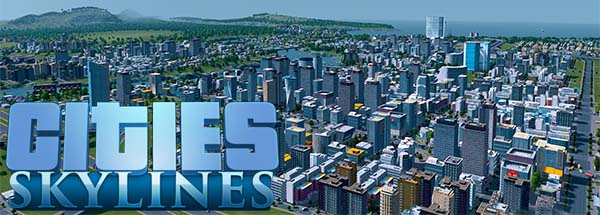
I've been on quite a city-builder bender this past eight months or so, and I've gone through quite a variety of games! From Tropico 5, to Cities XXL, Banished, and even a foray into the mobile game SimCity Buildit. Since the SimCity reboot in 2013 turned out to be a bust, I've been desperately searching for a modern game to fill the hole that was left after I moved on from SimCity 4. Cities XL held me over for a while, but my interest in it waned, and I was back to searching.
Well now that search can finally end, because I think I found my new, definitive city-builder: Cities: Skylines!
Almost immediately after starting a game, Skylines stands out as a very pretty game. The graphics have a very slight, cartoonish quality with very bright, vibrant colors. The animations are very smooth and fluid, which makes the map look very organic and alive. There's also some film grain and depth of field filters that can provide an immersive sense of being in the city when you zoom in. The depth of field effect only focuses on the center of the screen, which can look weird when you zoom very far in to look at certain objects. But if these effects become too bothersome, then you can always turn them off, and the game still looks great without them.
The various overlays are also very vibrant and have their own animations that show the flow of traffic along roads or water through pipes, and these overlays are also very pretty. The color contrasts also make them very easy to read and understand at a glance.
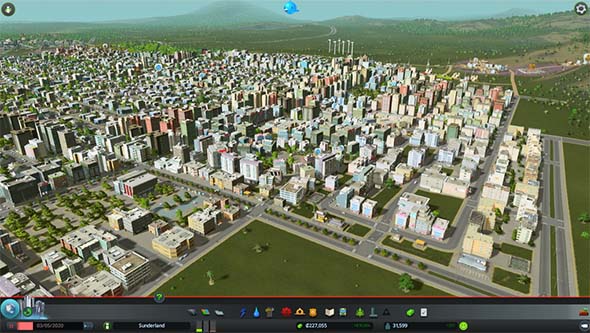
This game has very vibrant and attractive graphics and art styles that make the city look alive.
The game also has a very simple interface that looks good and is easy to read. Navigating through the menus is comfortable and intuitive, and it doesn't take up very much screen space.
Much like Cities XL, Skylines also gradually unlocks new buildings, infrastructure, and services as the city grows. Again, as somebody who routinely ran my SimCity 2000 cities into bankruptcy by overbuilding services and utility infrastructures early, I appreciate how this feature creates a gentler learning curve and helps to tutorialize new players in how the new features work.
Skylines differentiates itself from Cities XL and SimCity by providing a much more comfortable compromise of pacing and scale... [More]
b004b9b6-ce66-4953-8dd0-cc1289e3a97a|2|5.0
Tags:Cities: Skylines, Colossal Order Ltd., Paradox Interactive, Steam, Steam Workshop, city simulation, resources, roads, traffic, utilities, water pipes, power lines, garbage collection, cemetery, asset editor, policies
In anticipation of the upcoming Brave New World expansion pack for Sid Meier's Civilization V, I've been working on some mod projects.
Today, I published a small resource mod called "Just a pinch of salt" that adjusts the yield of the salt luxury resource. By default, salt is a very strong resource to start near, as it provides +1 food and +1 gold base yield. Since it shows up frequently on plains, these tiles give your fledgling city a 2 food, 1 production, 1 gold tile out of the gate. With the addition of a mine, the food and production yield goes up by 1.
Extra food from salt requires building a Granary.
This mod aims to scale back the power of salt a little bit by removing the base +1 food modifier and moving that bonus to require the construction of a Granary building. In addition to it's existing bonuses, the granary now adds the +1 food to salt.
- Salt: +1 Gold base yield.
- Granary: +1 Food from salt worked by the city.
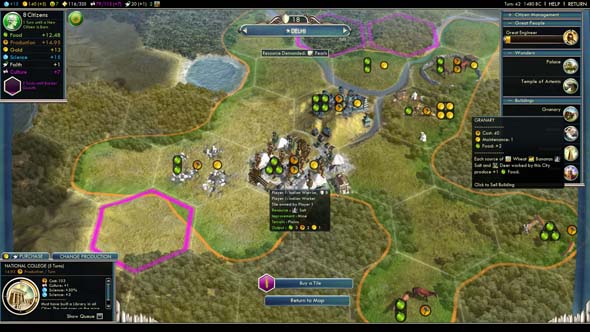
Total salt yield after building Granary and mine.
Once you have mined the salt and built a granary in the city, the total output of the salt tile is the same as in the unmodded game.
The mod can be downloaded from Civilization V's in-game mod browser by searching for "just a pinch of salt", or through Steam by visiting MegaBearsFan's Workshop (http://steamcommunity.com/sharedfiles/filedetails/?id=145306648). [More]
5e1bc327-3d30-442f-8225-1bb0e5f1bf70|2|4.0
Tags:Sid Meier's Civilization, Civilization, Civilization V, Civilization V: Gods & Kings, Civilization V: Brave New World, Civ V mod, modding, Steam, Steam Workshop, Valve, strategy, salt, granary, 2K Games, Just a pinch of salt, Civilization V
|

| 12 | | | | | | | 60 | | 11 | | | | | | | 55 | | 10 | | | | | | | 50 | | 09 | | | | | | | 45 | | 08 | | | | | | | 40 | | 07 | | | | | | | 35 | | 06 | | | | | | | 30 | | 05 | | | | | | | 25 | | 04 | | | | | | | 20 | | 03 | | | | | | | 15 | | 02 | | | | | | | 10 | | 01 | | | | | | | 05 |
|